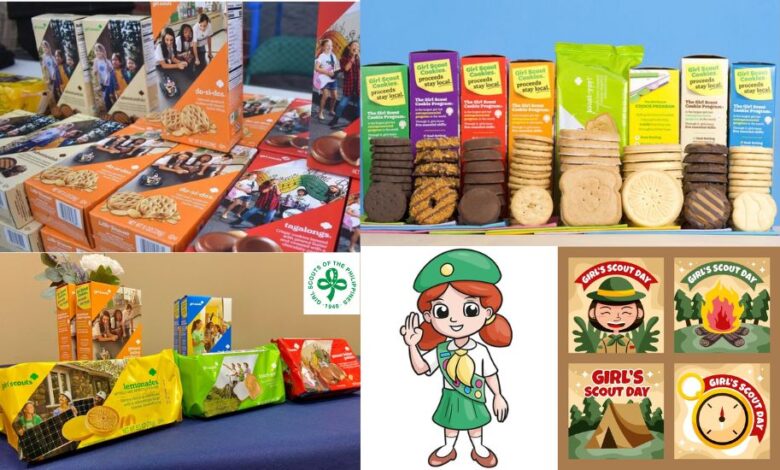Girl Scouts Cookies Lawsuit: Allegations, Reactions, and What It Means for Consumers

For over a century, Girl Scout Cookies have symbolized friendship, entrepreneurship, and community spirit. Every spring, millions of Americans eagerly purchase boxes of Thin Mints, Samoas, and Tagalongs to support young girls learning the value of business and leadership. But in early 2025, this cherished tradition faced an unexpected controversy — a lawsuit alleging that Girl Scout Cookies contain harmful levels of heavy metals and pesticides.
This revelation sparked national concern, legal scrutiny, and an ethical debate about food transparency, safety, and corporate responsibility — especially for an organization long associated with trust and wholesome values.
The Lawsuit That Shook an American Icon
In March 2025, a class-action lawsuit was filed in the U.S. District Court for the Eastern District of New York. The case — Mayo v. Girl Scouts of the United States of America et al. — named both the Girl Scouts of the USA (GSUSA) and its licensed bakers, including Ferrero U.S.A. and ABC Bakers, as defendants.
The plaintiff, Amy Mayo, a New York resident, claimed she purchased several varieties of Girl Scout Cookies believing they were safe and high-quality. However, she alleges the products contain dangerous contaminants, including lead, cadmium, arsenic, mercury, aluminum, and glyphosate — a widely used weed killer linked to potential health risks.
The lawsuit, seeking over $5 million in damages, accuses the defendants of:
- False and misleading advertising
- Breach of implied warranties
- Unjust enrichment
- Failing to disclose potential contaminants in the cookies
At the heart of the claim is the argument that the Girl Scouts’ reputation for safety and ethics gave consumers a false sense of trust, leading them to unknowingly buy potentially unsafe products.
The Trigger: A Controversial Study
The legal action was fueled by a December 2024 study commissioned by advocacy groups such as Moms Across America and GMO Science. Researchers reportedly tested 25 samples of Girl Scout Cookies from multiple U.S. states and found concerning results:
- 96% of samples contained lead
- 76% had cadmium above EPA water limits
- 100% contained glyphosate, the active ingredient in Roundup herbicide
- Some samples allegedly contained up to five heavy metals simultaneously
The study highlighted that Thin Mints, one of the most popular varieties, showed glyphosate levels “334 times higher than what scientists consider safe.”
The report’s findings quickly spread across news outlets, health blogs, and social media, igniting public anxiety. Parents and consumers began questioning how a youth-oriented organization could be associated with alleged toxins.
Girl Scouts’ Response: “Our Cookies Are Safe”
The Girl Scouts of the USA swiftly issued an official statement to reassure consumers. In a February 2025 blog post titled “An Important Update for Our Members and Supporters,” the organization declared that all Girl Scout Cookies are safe to consume and comply with FDA and EPA safety standards.
Their key points included:
- Trace amounts of heavy metals naturally occur in plant-based foods due to soil, air, and water exposure.
- The study’s comparisons used EPA water limits, not FDA food safety standards, making the conclusions misleading.
- The organization maintains strict quality control and testing procedures through its licensed bakers.
In short, the Girl Scouts insisted the cookies do not pose a food-safety risk and accused the lawsuit of “causing unnecessary alarm.”
What the Plaintiffs Claim
Despite GSUSA’s defense, the plaintiffs maintain that the contamination findings are significant enough to warrant legal accountability. Their claims center on three key points:
- Failure to Warn Consumers
- The lawsuit argues that GSUSA and its baking partners should have disclosed the potential for contaminants on packaging.
- Marketing terms like “safe,” “family-friendly,” and “wholesome” are seen as misleading when juxtaposed with alleged toxin levels.
- Ethical Responsibility
- The Girl Scouts’ cookie program is built on values — honesty, leadership, and community service.
- Selling possibly contaminated products through children undermines these values, the lawsuit claims.
- Consumer Trust and Financial Gain
- By promoting their cookies as safe and ethically produced, the organization allegedly profited from consumers’ misplaced trust.
The complaint also requests injunctive relief — a court order compelling GSUSA to implement clearer labeling and more transparent ingredient disclosures.
The Scientific Context: What Experts Say
Toxicology experts and nutrition scientists have urged the public to interpret the findings carefully. Several specialists interviewed by The Guardian and Verywell Health raised questions about the study’s methodology.
Key Criticisms:
- Not Peer-Reviewed: The study has not undergone formal scientific peer review, limiting its credibility.
- Small Sample Size: Only 25 cookie samples were tested, not enough to represent nationwide production.
- Wrong Comparison Metrics: The researchers compared results against EPA drinking water standards rather than food-specific safety limits set by the FDA.
- Trace Presence vs. Toxic Risk: Detecting trace levels of heavy metals does not automatically mean harmful exposure — many common foods contain natural residues below harmful thresholds.
Dr. Jennifer Martin, a food safety researcher quoted by Verywell Health, explained:
“While trace heavy metals can be found in many plant-based foods, the key question is exposure level and frequency. Occasional consumption of cookies is unlikely to cause harm for most people.”
Still, the lawsuit raises valid questions about transparency and public perception — particularly for products tied to children’s fundraising.
How Do Heavy Metals End Up in Food?
Understanding the source of these contaminants helps frame the discussion. Heavy metals such as lead, cadmium, and arsenic can enter food through:
- Soil and water contamination from industrial activity or old infrastructure
- Agricultural chemicals containing trace metals
- Processing and packaging materials that may leach elements during production
Since Girl Scout Cookies include plant-based ingredients like wheat, cocoa, and sugar, it’s plausible that trace elements could originate from raw materials, not deliberate additives.
However, the lawsuit argues that companies must still monitor, test, and disclose such risks — especially when the products are marketed as “safe for families.”
Public Reaction and Media Coverage
The lawsuit quickly went viral, trending across platforms like Twitter, Reddit, and TikTok, with hashtags such as #GirlScoutCookiesLawsuit and #ToxicCookies. Parents, health advocates, and environmental activists voiced mixed opinions.
- Some called for a temporary pause in cookie sales until the matter is resolved.
- Others defended the organization, arguing that the lawsuit could discourage girls from participating in a positive program.
Major outlets such as Reuters, Newsweek, and The Guardian covered the story extensively, highlighting both the plaintiffs’ concerns and GSUSA’s rebuttals.
Meanwhile, nutrition blogs have urged consumers not to panic, emphasizing moderation and context. “Enjoy your Thin Mints,” one writer joked, “just don’t treat them like a daily vegetable serving.”
Broader Implications for Food Transparency
Beyond the Girl Scouts, the lawsuit underscores a larger societal issue — the growing demand for transparency in food manufacturing. Consumers increasingly expect brands to disclose sourcing details, lab results, and potential risks, especially for products associated with children or health claims.
This case aligns with a broader trend of lawsuits targeting major food producers for alleged toxic contaminants or misleading health marketing, including:
- Gerber and Beech-Nut baby food lawsuits (heavy metals)
- Quaker Oats and Cheerios glyphosate cases
- Dark chocolate brands accused of containing lead and cadmium
Such cases reveal how consumer trust can erode quickly when safety claims clash with scientific reports — even when the science is contested.
Potential Legal and Business Outcomes
The Girl Scouts case is still in early stages, but several possible outcomes exist:
- Settlement Agreement:
The organization could agree to a monetary settlement without admitting fault, similar to previous food-related class actions. - Injunction and Labeling Changes:
Courts may order GSUSA to include disclaimers or ingredient testing information on packaging. - Dismissal for Lack of Evidence:
If the court finds the scientific basis insufficient, the case could be dismissed. - Reputational Damage and Sales Impact:
Even without a conviction, public perception could lead to reduced cookie sales and fundraising challenges.
Regardless of the verdict, the brand damage has already been significant. What was once a symbol of wholesome entrepreneurship now faces skepticism — and that trust may take years to rebuild.
Ethical Questions and Consumer Trust
This controversy raises deeper ethical questions about organizations involving children in commerce:
- Should youth-focused programs be held to higher safety standards?
- How transparent must they be about their supply chains and testing protocols?
- And how can they rebuild confidence once that trust is broken?
For the Girl Scouts, whose mission emphasizes integrity and community service, addressing these concerns openly may be the only way forward.
What Consumers Should Know
Until regulators or courts issue a decision, consumers can take a balanced approach:
- Check official statements: Refer to GSUSA’s website for safety updates.
- Practice moderation: Occasional indulgence in cookies is unlikely to pose major health risks.
- Stay informed: Follow FDA or consumer reports for verified data rather than viral claims.
- Support transparency: Encourage organizations to adopt clearer labeling and ingredient sourcing policies.
The Girl Scouts case may ultimately remind consumers that no brand — however trusted — is above accountability.
Conclusion
The Girl Scouts Cookies lawsuit represents more than just a legal battle; it’s a test of trust in one of America’s most beloved institutions. Whether or not the allegations hold up in court, the case highlights a growing tension between corporate transparency, consumer safety, and public perception.
As science and law converge, one truth stands out — accountability in the food industry matters as much as taste. For now, both the Girl Scouts and their loyal customers are left navigating a complex mix of tradition, responsibility, and modern scrutiny.
— Written for Newsta

